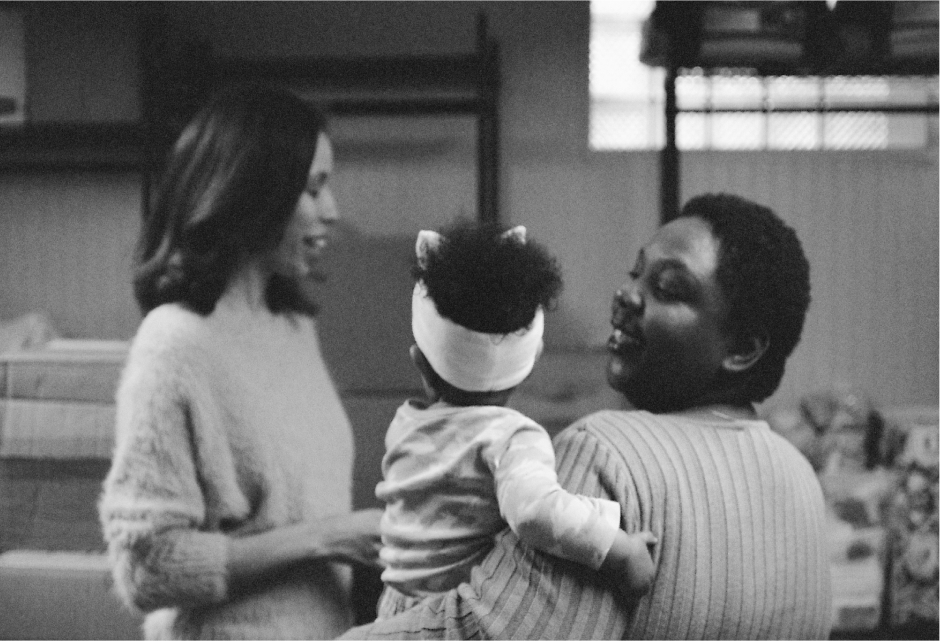I think of the women who came before: A Pictorial Quilt of Reproductive Justice in Cleveland
CARMEN WINANT
Photographer
I began this project as I often do: with an outsize sized idea informed by my own fascination with and dedication to evolving feminist values, histories, and coalition-making strategies.
When I’m lucky and my eyes are open, a project about an “idea” rapidly becomes a project about people. There is no such thing as feminism with feminists, there is no such thing as reproductive justice without reproductive justice workers. I learn and re-learn this lesson on every project: that human beings make these organizations work and run, and that they – who are both pictured in this work and enable its conditions – are the most fitting subject of creative inquiry-making and mutual care networking.
The annual theme of 2022-2023 George Gund photography commission is reproductive justice; as the artist selected to contend with this subject, and as a resident of Ohio, I sought to better understand the clinics and health center landscape around Cleveland. It was important to at once make photographs of the people doing this work in the present moment as well as to reach back in history – in some cases, to before the point that abortion was legalized in 1972 – and braid together those found and authored images in larger sets. Time was not to function linearly, but more like a constellation in which photographs of reproductive care works across decade met one another.

I began conversations around this project after the Dobbs decision was leaked and just weeks before it was formally announced. Because I live in Columbus (just a few miles from the statehouse), I was at that point already subject to the so-called “heartbeat bill” which denies legal and safe abortion between five or six weeks after conception (and around which no exceptions are made for “hard cases” such as rape, incest, or a fetus determined to possibly have Down syndrome). Folks were mobilizing, but there was, and is, also so much despair. While this project works to picture reproductive justice workers for all they do – from pap smears to birth work to gender affirming care – to not name abortion as an urgent part of this picture, at this moment, would be entirely misguided. The stripping of that essential right undergirded my desire to make this project, and learn from the workers who are and were engaged in care, advocacy, and struggle.
The project started slowly: I asked friends and comrades who they knew in Cleveland who were engaged in this work. When I met people, I asked them too. Barbara Tannenbaum, the curator of photography at the Cleveland Museum of Art, pointed me to Roberta Aber, who pointed me to Bonnie Bolitho and Betsey Kaufman, the former CEOs of greater planned parenthood in Canton and Cleveland, respectively, who hosted me at their home many times. I found my way to the Western Reserve Historical Society, which holds the regional planned parenthood papers, and to Cleveland State University’s Special Collections, where a generous librarian Elizabeth Piwkowski helped me locate and scan a portion of the Womanspace photographs from their albums. Perhaps most meaningfully of all, I found my way to Preterm, a clinic that has been opened since 1974. With the utmost generosity, Sri Thakkilapati and Colleen Damerell surfaced their archival material for me, allowing me to scan photographs from their collection as I needed. I also recorded audio interviews with Sri, along with Chrisse France (the former director of preterm), and Bonnie and Betsey. This work does and cannot exist without these acts of trust and openness; they make everything possible, and I am so, so grateful.
Perhaps the greatest challenge of all was making my own pictures for this project, an exercise that I have fallen out of practice with. While I am trained as a photographer, and teach photography to students at OSU, I moved away from shooting pictures for my own work in favor of using archival materials over fifteen years ago. In making this project, I returned to shooting 35mm film – at Preterm, with Bonnie and Betsey, the staff of Birthing Beautiful Communities in Cleveland, and with Iris Harvey, the President and CEO of Planned Parenthood of Greater Ohio, in a health center in Akron. While historical legacy is crucial to this work, too it matters to see it in real time and space, and make sense of reproductive justice care work on a continuum.
It is my hope that this work points to the normalcy of this healthcare work, thereby working to undermine its stigma. These are pictures of (almost exclusively) women staffers answering the phone, readying rooms for patients, having birthday parties in the office, and inputting appointment information into computers. For lack of a better word, this work is unsensational, and the pictures I have made, as with the pictures I have drawn from in the archive, meaningly – powerfully – reflect just that.
CARMEN WINANT
Photographer